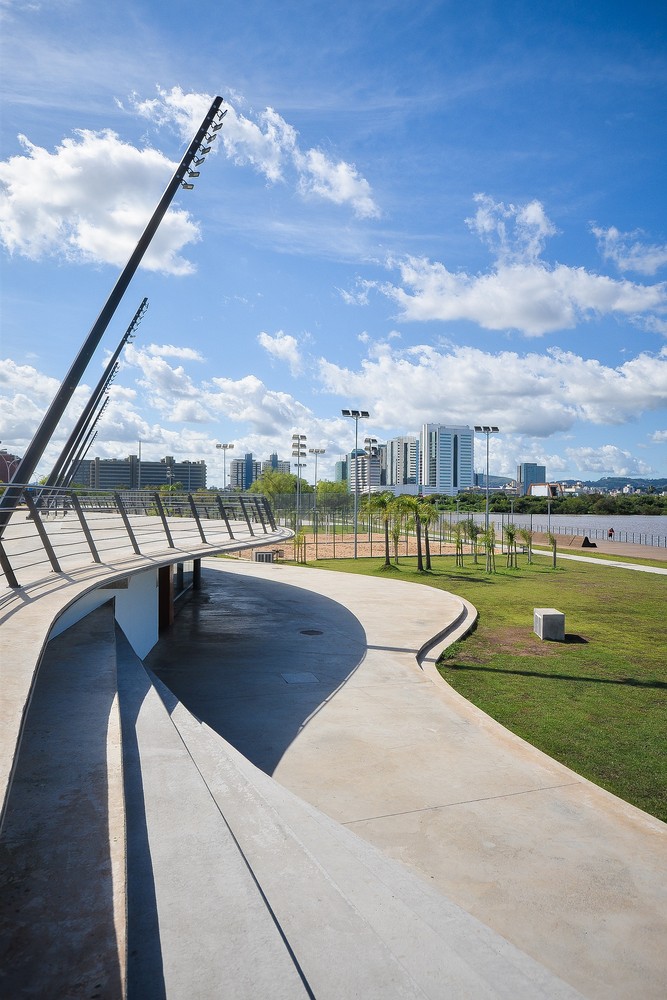Ferrari Restaurant Marco Visconti
2013-07-11 01:00
架构师提供的文本描述。这项工作的明确特征唤起了与周围工业场所的几何严谨性相比,新建筑的明显的正式区别:这种充满象征意义的规划成功地在工厂内创建了一个明确可识别的实体,明确地为客人和雇员的放松设想。其安排的基本内容是将两个与空气动力学概念相关的卷并列起来,如巨大的悬挂翼形展馆,置于飞行位置,由垂直放置在地面上的另一个交错轴机翼支撑。餐厅是整个建筑的核心,它位于与主悬挂体积相对应的上翼内。这个锥形的空间位于玻璃大厅之上:一个两层高的空间,用来接待和引导食客到达上面的空间,并连接到指定的员工福利场所和培训中心。从技术和操作的角度来看,复杂的工作得益于附件的体积,如厨房,储存和技术空间包含在垂直机翼。
Text description provided by the architects. The clear-cut features of this work evoke the distinct formal differentiation of the new building compared to the geometrical rigor of the surrounding industrial premises: such planning, full of symbolism, succeeds in creating, within the plant, a clearly recognizable entity expressly conceived for the relaxation of guests and employees. The basics of its arrangement consist in the juxtaposing of two volumes linked to concepts of aerodynamics, as represented by the great hanging wing-shaped pavilion, placed in a flight position, supported by another, staggered-axis wing positioned vertically on the ground. The dining hall, the core of the entire building, is found inside the upper wing corresponding to the main hanging volume. This tapered section space rests over the glazed hall: a two-storey volume formed so as to receive and lead the diners to the spaces above, and is connected to the places appointed for employees’ well-being and the training center. From a technological and operating point of view, the complex works thanks to the accessory volumes such as kitchens, storage and technical spaces contained in the vertical wing.
内部布置分为三个地面层次.底层包括一个有盖的广场、入口大厅和咖啡厅/快餐店,穿过通往餐厅的楼梯系统。咖啡厅、健康中心、医务室和运动中心等服务空间朝向全玻璃大厅,而独立的位置与外部直接相连,我们发现厨房内设有食品储藏室、更衣室和服务电梯,供准备好的菜肴到达不同楼层。第一层设有培训中心:这一功能包括教室和投影室,与俯瞰厨房的宽敞的水磨石相连,用作花园。训练中心通向一个面向内厅的阳台,里面有一个专用的放松区。二楼可容纳餐厅,完全玻璃化,并与外部水磨石连接,向南延伸到维安恩佐法拉利路。这一空间,也可作为一个区域的接触和介绍,是一个系统的表与多边形设计定位在一个不统一的方式,目的是能够创造各种空间和座位安排。餐厅还设有“自由流动”的食物分发区,旁边是准备室和洗碗室。您可以通过一系列楼梯和自动扶梯进入餐厅,这些楼梯和自动扶梯可以引导餐车从大厅和第一层到达。最后,这层楼还有经理餐厅,面向北到一个挂着的花园。
The interior arrangement is split over three above-ground levels. The ground floor includes a covered piazza, entrance hall and coffee shop/snack bar, crossed by the stairway system that leads to the restaurant. Service spaces such as coffee zones, a wellness center, the infirmary and sports center face toward the totally glazed hall, while in an independent position and directly connected to the exterior, we find the kitchen complete with food larders, changing rooms and service elevators for prepared dishes to reach the various floors. The first level accommodates the training center: this function includes classrooms and projection rooms, connected to an ample terrazzo overlooking the kitchen and used as a garden. The training center leads on to a balcony facing the inner hall, containing a dedicated relaxation area. The second floor accommodates the restaurant dining hall, completely glazed and connected to an external terrazzo projecting southwards to the Via Enzo Ferrari road. This space, usable also as an area for encounters and presentations, is fitted out with a system of tables with a polygonal design positioned in a non-uniform way with the aim of being able to create various spaces and seating arrangements. The restaurant is also served by “free flow” food distribution areas and is flanked by the preparation and dish-washing rooms. You access it via a series of stairs and escalators that direct the flow of diners arriving from the hall and from the first level. Finally, this floor also has the managers’ dining room facing northwards on to a hanging garden.
关于建筑中主要可持续性因素的使用,复杂的解释了被动生物气候的最新经验。根据建筑物的使用时间,分析了外部表面和正面受到太阳射线照射的程度:机翼向南靠近,东面和西面的玻璃在使用期间遮阳。包含厨房和服务空间的垂直机翼被通风的立面覆盖,这避免了夏季不透明部件和窗户的过热,而高尾支撑着工厂工程系统。自然遮阳的来源,如有着古铜色叶子的植物,在西面被使用,以保护入口大厅的玻璃。悬挂花园具有自然保护免受直接阳光照射的功能,而水平翼被水平波纹板覆盖,当被强风覆盖时,可形成通风室。
As regards the use of main sustainability-in-architecture factors, the complex interprets the most recent experiences of passive bio-climatics. The degree of exposure to the sun’s rays of the outer surfaces and façades has been analyzed in relation to the building’s usage times: the wing shape is closed towards the South, and the glazing facing East and West is shaded during the usage period. The vertical wing containing the kitchens and service spaces are covered by a ventilated façade, which avoids the summer overheating of opaque parts and windows, while the high tail holds the plant-engineering systems. Sources of natural shading, such as plants with caduceus leaves, are employed along the West façade in order to protect the entrance hall glazing. The hanging garden has the function of natural protection from direct sunlight, while the horizontal wing is covered with horizontal corrugated sheets that, when lapped by dominating winds, can create a ventilating chamber.
它的基本概念包括高功能能力、使用它的人的愉悦性、自然的存在和对美学的重视。体积形状的可塑性使建筑摆脱了通常以高脚落差率为特征的刚性块,室内动态设计允许并促进了社会交往,巨大的玻璃表面放大了空间感知。这些特点使餐厅成为一个平衡的工作,能够吸引人们而不失去与它的技术方面,它的可持续性,以及更基本的围绕它的东西:自然。
Fundamental concepts underlie this work, like its high functional capability, pleasantness for people using it, the presence of nature and the attention paid to the esthetics. The plasticity of the volumetric forms free the building from the rigid blocks that generally characterize areas destined for high foot-fall rates, the dynamic design of the interiors allows and facilitates socializing and the huge glazed surfaces amplify the space perception. These features make the restaurant a balanced work, able to fascinate people without losing contact with its technical side, its sustainability, and that which is more fundamental surrounding it: nature.
First Floor Plan - Restaurant
 举报
举报
别默默的看了,快登录帮我评论一下吧!:)
注册
登录
更多评论
相关文章
-

描边风设计中,最容易犯的8种问题分析
2018年走过了四分之一,LOGO设计趋势也清晰了LOGO设计
-

描边风设计中,最容易犯的8种问题分析
2018年走过了四分之一,LOGO设计趋势也清晰了LOGO设计
-

描边风设计中,最容易犯的8种问题分析
2018年走过了四分之一,LOGO设计趋势也清晰了LOGO设计






















































































